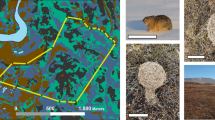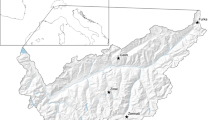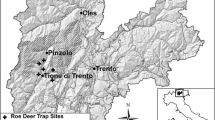Abstract
During the cold arctic winter, small mammals like lemmings seek refuge inside the snowpack to keep warm and they dig tunnels in the basal snow layer, usually formed of a soft depth hoar, to find vegetation on which they feed. The snowpack, however, is a heterogenous medium and lemmings should use habitats where snow properties favor their survival and winter reproduction. We determined the impact of snow physical properties on lemming habitat use and reproduction in winter by sampling their winter nests for 13 years and snow properties for 6 years across 4 different habitats (mesic, riparian, shrubland, and wetland) on Bylot Island in the Canadian High Arctic. We found that lemmings use riparian habitat most intensively because snow accumulates more rapidly, the snowpack is the deepest and temperature of the basal snow layer is the highest in this habitat. However, in the deepest snowpacks, the basal depth hoar layer was denser and less developed than in habitats with shallower snowpacks, and those conditions were negatively related to lemming reproduction in winter. Shrubland appeared a habitat of moderate quality for lemmings as it favored a soft basal snow layer and a deep snowpack compared with mesic and wetland, but snow conditions in this habitat critically depend on weather conditions at the beginning of the winter. With climate change, a hardening of the basal layer of the snowpack and a delay in snow accumulation are expected, which could negatively affect the winter habitat of lemmings and be detrimental to their populations.






Similar content being viewed by others
Data availability
The lemming data analysed in this study are available from the NordicanaD repository (https://doi.org/10.5885/45400AW-9891BD76704C4CE2) and the other datasets are available from the corresponding author.
References
Audet B, Gauthier G, Lévesque E (2007) Feeding ecology of greater snow goose goslings in mesic tundra on Bylot Island, Nunavut, Canada. Condor 109:361–376
Banks EM, Brooks RJ, Schnell J (1975) A radiotracking study of home range and activity of the brown lemming (Lemmus trimucronatus). J Mammal 56:888–901
Barrere M, Domine F, Belke-Brea M, Sarrazin D (2018) Snowmelt events in autumn can reduce or cancel the soil warming effect of snow-vegetation interactions in the arctic. J Clim 31:9507–9518
Barton K (2022) MuMIn: Multi-model inference. R package version 0.12.2
Batzli GO, Pitelka FA, Cameron GN (1983) Habitat use by lemming near Barrow, Alaska. Holarct Ecol 6:255–262
Berteaux D, Gauthier G, Domine F, Ims RA, Lamoureux SF, Lévesque E, Yoccoz N (2017) Effects of changing permafrost and snow conditions on tundra wildlife: critical places and times. Arctic Sci 3:65–90
Bilodeau F, Gauthier G, Berteaux D (2013) The effect of snow cover on lemming population cycles in the Canadian High Arctic. Oecologia 172:1007–1016
Boonstra R, Andreassen HP, Boutin S, Hušek J, Ims RA, Krebs CJ, Skarpe C, Wabakken P (2016) Why do the boreal forest ecosystems of Northwestern Europe differ from those of Western North America? Bioscience 66:722–734
Buckland ST, Anderson DR, Burnham KP, Laake JL, Borchers DL, Thomas L (2004) Advanced distance sampling: estimating abundance of biological populations. Oxford University Press, London
Chami P, Antoine R, Sahai A (2007) On efficient confidence intervals for the log-normal mean. J Appl Sci 7:1790–1794
Chappell MA (1980) Thermal energetics and thermoregulatory costs of small arctic mammals. J Mammal 61:278–291
Coe PK, Clark DA, Nielson RM, Gregory SC, Cupples JB, Hedrick MJ, Johnson BK, Jackson DH (2018) Multiscale models of habitat use by mule deer in winter. J Wildl Manag 82:1285–1299
Conger SM, McClung DM (2009) Instruments and methods: comparison of density cutters for snow profile observations. J Glaciol 55:163–169
Dolant C, Montpetit B, Langlois A, Brucker L, Zolina O, Johnson CA, Royer A, Smith P (2018) Assessment of the barren ground caribou die-off during winter 2015–2016 using passive microwave observations. Geophys Res Lett 45:4908–4916
Domine F, Taillandier AS, Cabanes A, Douglas TA, Sturm M (2009) Three examples where the specific surface area of snow increased over time. Cryosphere 3:31–39
Domine F, Bock J, Morin S, Giraud G (2011) Linking the effective thermal conductivity of snow to its shear strength and density. J Geophys Res Earth Surf 116:1–10
Domine F, Gallet JC, Bock J, Morin S (2012) Structure, specific surface area and thermal conductivity of the snowpack around Barrow, Alaska. J Geophys Res Atmos 117:1–12
Domine F, Barrere M, Morin S (2016) The growth of shrubs on high Arctic tundra at Bylot Island: impact on snow physical properties and permafrost thermal regime. Biogeosci Discuss 13:6471–6486
Domine F, Belke-Brea M, Sarrazin D, Arnaud L, Poirier M, Joint T (2018a) Soil moisture, wind speed and depth hoar formation in the Arctic snowpack. J Glaciol 64:1–29
Domine F, Gauthier G, Vionnet V, Fauteux D, Dumont M, Barrere M (2018b) Snow physical properties may be a significant determinant of lemming population dynamics in the high Arctic. Arctic Sci 4:813–826
Domine F, Lackner G, Sarrazin D, Poirier M, Belke-Brea M (2021) Meteorological, snow and soil data (2013–2019) from a herb tundra permafrost site at Bylot Island, Canadian high Arctic, for driving and testing snow and land surface models. Earth Syst Sci Data 13:4331–4348
Domine F, Fourteau K, Picard G, Lackner G, Sarrazin D, Poirier M (2022) Permafrost cooled in winter by thermal bridging through snow-covered shrub branches. Nat Geosci 15:554–560
Duchesne D, Gauthier G, Berteaux D (2011a) Habitat selection, reproduction and predation of wintering lemmings in the Arctic. Oecologia 167:967–980
Duchesne D, Gauthier G, Berteaux D (2011b) Evaluation of a method to determine the breeding activity of lemmings in their winter nests. J Mammal 92:511–516
Fauteux D, Gauthier G (2022) Density-dependent demography and movements in a cyclic brown lemming population. Ecol Evol 12:e9055
Fauteux D, Gauthier G, Berteaux D (2015) Seasonal demography of a cyclic lemming population in the Canadian Arctic. J Anim Ecol 84:1412–1422
Fauteux D, Gauthier G, Berteaux D (2016) Top-down limitation of lemmings revealed by experimental reduction of predators. Ecology 97:3231–3241
Fauteux D, Slevan-Tremblay G, Gauthier G, Berteaux D (2017) Feeding preference of brown lemmings (Lemmus trimucronatus) for plant parts of Arctic willow (Salix arctica). Polar Biol 40:2329–2334
Feng C, Wang H, Lu N, Chen T, He H, Lu Y, Tu XM (2014) Log-transformation and its implications for data analysis. Shanghai Arch Psychiatry 26:105–109
Fourteau K, Hagenmuller P, Roulle J, Domine F (2022) On the use of heated needle probes for measuring snow thermal conductivity. J Glaciol 68:705–719
Fuller WA, Martell AM, Smith RFC, Speller SW (1975) High-arctic lemmings, Dicrostonyx groenlandicus. II Demography. Can J Zool 53:867–878
Gallet J-CC, Domine F, Zender CS, Picard G (2009) Measurement of the specific surface area of snow using infrared reflectance in an integrating sphere at 1310 and 1550 nm. Cryosphere 3:167–182
Gauthier G, Berteaux D, Bêty J, Tarroux A, Therrien J-F, McKinnon L, Legagneux P, Cadieux M-C (2011) The tundra food web of Bylot Island in a changing climate and the role of exchanges between ecosystems. Ecoscience 18:223–235
Gauthier G, Bêty J, Cadieux M-C, Legagneux P, Doiron M, Chevallier C, Lai S, Tarroux A, Berteaux D (2013) Long-term monitoring at multiple trophic levels suggests heterogeneity in responses to climate change in the Canadian Arctic tundra. Philos Trans Royal Soc London Sers B, BiolSci 368:20120482
Gilg O, Hanski I, Sittler B (2003) Cyclic dynamics in a simple vertebrate predator-prey community. Science 302:866–868
Gilg O, Sittler B, Hanski I (2009) Climate change and cyclic predator-prey population dynamics in the high Arctic. Glob Change Biol 15:2634–2652
Glass TW, Breed GA, Liston GE, Reinking AK, Robards MD, Kielland K (2021) Spatiotemporally variable snow properties drive habitat use of an Arctic mesopredator. Oecologia 195:887–899
Halpin MA, Bissonette JA (1988) Influence of snow depth on prey availability and habitat use by red fox. Can J Zool 66:587–592
Hansen BB, Aanes R, Herfindal I, Kohler J, Seather B-E (2011) Climate, icing, and wild arctic reindeer: past relationships and future prospects. Ecology 92:1917–1923
Hansen BB, Isaksen K, Benestad RE, Kohler J, Pedersen Å, Loe LE, Coulson SJ, Larsen JO, Varpe Ø (2014) Warmer and wetter winters: characteristics and implications of an extreme weather event in the high Arctic. Environ Res Lett 9:114021
Ims RA, Henden JA, Killengreen ST (2008) Collapsing population cycles. Trends Ecol Evol 23:79–86
Kausrud KL, Mysterud A, Steen H, Vik JO, Østbye E, Cazelles B, Framstad E, Eikeset AM, Mysterud I, Solhøy T, Stenseth NC (2008) Linking climate change to lemming cycles. Nature 456:93–97
Langlois A, Johnson CA, Montpetit B, Royer A, Blukacz-Richards EA, Neave E, Dolant C, Roy A, Arhonditsis G, Kim DK, Kaluskar S, Brucker L (2017) Detection of rain-on-snow (ROS) events and ice layer formation using passive microwave radiometry: a context for Peary caribou habitat in the Canadian Arctic. Remote Sens Environ 189:84–95
Le Vaillant M, Erlandsson R, Elmhagen B, Hörnfeldt B, Eide NE, Angerbjörn A (2018) Spatial distribution in Norwegian lemming Lemmus lemmus in relation to the phase of the cycle. Polar Biol 41:1391–1403
Liston GE, Hiemstra CA (2011) The changing cryosphere: Pan-Arctic snow trends (1979–2009). J Clim 24:5691–5712
MacLean SF, Fitzgerald BM, Pitelka FA (1974) Cycles in arctic lemmings: winter reproduction and predation by weasels. Arct Alp Res 6:1–12
Marbouty D (1980) An experimental study of temperature-gradient metamorphism. J Glaciol 26:303–312
Martin ME, Moriarty KM, Pauli JN (2020) Forest structure and snow depth alter the movement patterns and subsequent expenditures of a forest carnivore, the Pacific marten. Oikos 129:356–366
Millar JS (2001) On reproduction in lemmings. Ecoscience 8:145–150
Miller DL, Rexstad E, Thomas L, Laake JL, Marshall L (2019) Distance sampling in R. J Stat Softw 89:1–28
Morin S, Domine F, Arnaud L, Picard G (2010) In-situ monitoring of the time ecvolution of the effective thermal conductivity of snow. Cold Reg Sc Technol 64:73–80
Morris DW, Davidson DL, Krebs CJ (2000) Measuring the ghost of competition: Insights from density-dependent habitat selection on the co-existence and dynamics of lemmings. Evol Ecol Res 2:41–67
Nakagawa S, Schielzeth H (2013) A general and simple method for obtaining R2 from generalized linear mixed-effects models. Methods Ecol Evol 4:133–142
Poirier M, Gauthier G, Domine F (2019) What guides lemmings movements through the snowpack? J Mammal 100:1416–1426
Poirier M, Fauteux D, Gauthier G, Domine F, Lamarre JF (2021) Snow hardness impacts intranivean locomotion of arctic small mammals. Ecosphere 12:e03835
Pomeroy JWW, Brun E (1990) Physical properties of snow. Snow Ecol 97:45–126
Predavec M, Krebs CJ (2000) Microhabitat utilisation, home ranges, and movement patterns of the collared lemming (Dicrostonyx groenlandicus) in the central Canadian Arctic. Can J Zool 78:1885–1890
R Core Team (2021) R: A language and environment for statistical computing. R Foundation for Statistical Computing, Vienna, Austria
Reid DG, Bilodeau F, Krebs CJ, Gauthier G, Alice J, Gilbert BS, Leung MC, Duchesne D, Hofer E (2012) Lemming winter habitat choice : a snow-fencing experiment. Oecologia 168:935–946
Rennert KJ, Roe G, Putkonen J, Bitz CM (2009) Soil thermal and ecological impacts of rain on snow events in the circumpolar arctic. J Clim 22:2302–2315
Schmidt NM, Van Beest FM, Dupuch A, Hansen LH, Pierre J, Morris DW (2021) Long - term patterns in winter habitat selection, breeding and predation in a density - fluctuating, high Arctic lemming population. Oecologia 195:927–935
Seyer Y, Gauthier G, Fauteux D, Therrien JF (2020) Resource partitioning among avian predators of the Arctic tundra. J Anim Ecol 89:2934–2945
Soininen EM, Gauthier G, Bilodeau F, Berteaux D, Gielly L, Taberlet P, Gussarova G, Bellemain E, Hassel K, Stenøien HK, Epp L, Schrøder-Nielsen A, Brochmann C, Yoccoz NG (2015) Highly overlapping winter diet in two sympatric lemming species revealed by DNA metabarcoding. PLoS ONE 10:1–18
Sorum MS, Joly K, Wells AG, Cameron MD, Hilderbrand GV, Gustine DD (2019) Den-site characteristics and selection by brown bears (Ursus arctos) in the central Brooks Range of Alaska. Ecosphere 10:e02822
St-Georges M, Nadeau S, Lambert D (1995) Winter habitat use by ptarmigan, snowshoe hares, red foxes, and river otters in the boreal forest - tundra transition zone of western Quebec. Can J Zool 73:755–764
Stien A, Ims RA, Albon SD, Fuglei E, Irvine RJ, Ropstad E, Halvorsen O, Langvatn R, Loe LE, Veiberg V, Yoccoz NG (2012) Congruent responses to weather variability in high arctic herbivores. Biol Let 8:1002–1005
Sturm M, Benson CS (1997) Vapor transport, grain growth and depth-hoar development in the subarctic snow. J Glaciol 43:42–59
Sturm M, Benson C (2004) Scales of spatial heterogeneity for perennial and seasonal snow layers. Ann Glaciol 38:253–260
Sturm M, Holmgren J, Liston GE (1995) A seasonal snow cover classification system for local to global applications. J Clim 8:1261–1283
Sturm M, Holmgren J, König M, Morris K (1997) Thermal conductivity of seasonal snow. J Glaciol 43:26–41
Sturm M, McFadden JP, Liston GE, Chapin S III, Racine CH, Holmgren J (2001) Snow – shrub interactions in arctic tundra : a hypothesis with climatic implications. J Clim 14:336–344
Tape K, Sturm M, Racine C (2006) The evidence for shrub expansion in Northern Alaska and the Pan-Arctic. Glob Change Biol 12:686–702
Venables WN, Ripley BD (2002) Modern applied statistics with S, 4th edn. Springer-Verlag, New York
Von Beckerath X, Benadi G, Gilg O, Sittler B, Yannic G, Klein A-M, Eitzinger B (2021) Long-term monitoring reveals topographical features and vegetation explain winter habitat use of an arctic rodent. Arctic Sci 8:349–361
Zhang T (2005) Influence of the seasonal snow cover on the ground thermal regime: an overview. Rev Geophys 43:4002
Acknowledgements
We thank Gabriel Bergeron, James Akpaleeapik, Madelaine Proulx, Qalaapik Enookolo, Jaimie Vincent and all the other people involved in the long-term monitoring of lemming winter nests in the field. We also thank Mathieu Barrère and Marianne Valcourt for their help with snow sampling. We thank Marie-Christine Cadieux for her precious help regarding database management. We thank Christophe Kinnard for sharing Reconyx data with us and Denis Sarrazin for his technical support with automated weather stations. We also thank David Bolduc for his help with the map in appendix.
Funding
This work was funded by Sentinel North program of the Canada First Research Excellence Fund, the Fonds de recherche du Québec—Nature et technologies, the Natural Sciences and Engineering Research Council of Canada, the Polar Continental Shelf Program of Natural Resources Canada, the ArcticNet Network of Centre of Excellence, the Fondation de l’Université Laval and the W. Garfield Weston Foundation.
Author information
Authors and Affiliations
Contributions
MP, FD, DF conducted fieldwork. MP performed statistical analyses, with support from DF and GG. MP wrote the original manuscript draft with substantial contribution from GG, FD, DF. GG and FD co-supervised the project and obtained funding.
Corresponding author
Ethics declarations
Conflict of interest
The authors declare that they have no conflict of interest.
Additional information
Communicated by Jean-François Le Galliard.
We documented the favorable role of deep snow in lemming habitat use, as well as its tradeoff as harder snow was found in deeper snowpack, which has a negative impact on lemming winter reproduction.
Supplementary Information
Below is the link to the electronic supplementary material.
Rights and permissions
Springer Nature or its licensor (e.g. a society or other partner) holds exclusive rights to this article under a publishing agreement with the author(s) or other rightsholder(s); author self-archiving of the accepted manuscript version of this article is solely governed by the terms of such publishing agreement and applicable law.
About this article
Cite this article
Poirier, M., Gauthier, G., Domine, F. et al. Lemming winter habitat: the quest for warm and soft snow. Oecologia 202, 211–225 (2023). https://doi.org/10.1007/s00442-023-05385-y
Received:
Accepted:
Published:
Issue Date:
DOI: https://doi.org/10.1007/s00442-023-05385-y




